Development of a Fault-Diagnosis System through the Power Conversion Module of an Electric Vehicle Fast Charger
Abstract
:1. Introduction
2. Materials and Methods
2.1. Development of Electric Vehicle Fast-Charger Power Module Failure-Prediction and Management System
2.2. Development of Remote Data-Based Fast-Charger Fault-Diagnosis Technology
3. Results and Discussion
Classification of Fast-Charger Charging Patterns Using Deep-Learning-Based MLP Algorithm
4. Conclusions
Author Contributions
Funding
Institutional Review Board Statement
Informed Consent Statement
Data Availability Statement
Conflicts of Interest
References
- Pallonetto, F.; Galvani, M.; Torti, A.; Vantini, S. A framework for analysis and expansion of public charging infrastructure under fast penetration of electric vehicles. World Electr. Veh. J. 2020, 11, 18. [Google Scholar] [CrossRef] [Green Version]
- Suarez, C.; Martinez, W. Fast and ultra-fast charging for battery electric vehicles–A review. In Proceedings of the 2019 IEEE Energy Conversion Congress and Exposition (ECCE), Baltimore, MD, USA, 29 September–3 October 2019; pp. 569–575. [Google Scholar] [CrossRef]
- De Quevedo, P.M.; Muñoz-Delgado, G.; Contreras, J. Impact of electric vehicles on the expansion planning of distribution systems considering renewable energy, storage, and charging stations. IEEE Trans. Smart Grid. 2019, 10, 794–804. [Google Scholar] [CrossRef]
- Wu, Y.A.; Ng, A.W.; Yu, Z.; Huang, J.; Meng, K.; Dong, Z.Y. A review of evolutionary policy incentives for sustainable development of electric vehicles in China: Strategic implications. Energy Policy 2021, 148, 111983. [Google Scholar] [CrossRef]
- Afshar, S.; Macedo, P.; Mohamed, F.; Disfani, V. A literature review on mobile charging station technology for electric vehicles. In Proceedings of the 2020 IEEE Transportation Electrification Conference & Expo (ITEC), Chicago, IL, USA, 23–26 June 2020; pp. 1184–1190. [Google Scholar] [CrossRef]
- Morrissey, P.; Weldon, P.; O’Mahony, M. Future standard and fast charging infrastructure planning: An analysis of electric vehicle charging behaviour. Energy Policy 2016, 89, 257–270. [Google Scholar] [CrossRef]
- Viana, C.; Lehn, P.W. A drivetrain integrated DC fast charger with buck and boost functionality and simultaneous drive/charge capability. IEEE Trans. Transp. Electrif. 2019, 5, 903–911. [Google Scholar] [CrossRef]
- Fang, X.; Li, J.; Zhang, X.; Chen, W.; Wang, W. Study on Temperature Control Design and High Protection of Charger. In Proceedings of the 2018 10th International Conference on Intelligent Human-Machine Systems and Cybernetics (IHMSC), Hangzhou, China, 25–26 August 2018; pp. 216–219. [Google Scholar] [CrossRef]
- Alavi, S.M.M.; Fekriasl, S.; Niyakan, S.N.; Saif, M. Fault detection and isolation in batteries power electronics and chargers. J. Energy Storage 2019, 25, 100807. [Google Scholar] [CrossRef]
- Chen, W.; Wang, L.; Ulatowski, A.; Bazzi, A.M. A fuzzy logic approach for fault diagnosis and recovery in PHEV and EV chargers. In Proceedings of the 2014 IEEE Transportation Electrification Conference and Expo (ITEC), Dearborn, MI, USA, 15–18 June 2014; pp. 1–5. [Google Scholar] [CrossRef]
- Yan, Q.; Dong, H.; Zhang, M. Service evaluation of electric vehicle charging station: An application of improved matter-element extension method. Sustainability 2021, 13, 7910. [Google Scholar] [CrossRef]
- Zhang, L.; Zhao, Z.; Yang, M.; Li, S. A multi-criteria decision method for performance evaluation of public charging service quality. Energy 2020, 195, 116958. [Google Scholar] [CrossRef]
- Chaurasiya, S.; Mishra, N.; Singh, B. A 50kW bidirectional fast EV charger with G2V & V2G/V2V capability and wide voltage range. In Proceedings of the 2020 IEEE 5th International Conference on Computing Communication and Automation (ICCCA), Greater Noida, India, 30–31 October 2020; pp. 652–657. [Google Scholar] [CrossRef]
- Kuperman, A.; Levy, U.; Goren, J.; Zafranski, A.; Savernin, A.; Peled, I. Modeling and control of a 50KW electric vehicle fast charger. In Proceedings of the 2010 IEEE 26th Convention of Electrical and Electronics Engineers, Eilat, Israel, 17–20 November 2010; pp. 188–192. [Google Scholar] [CrossRef]
- Yoon, H.; Kim, J.; Song, E. Design of a novel 50 kW fast charger for electric vehicles. J. Cent. South Univ. 2013, 20, 372–377. [Google Scholar] [CrossRef]
- Gardner, M.W.; Dorling, S.R. Artificial neural networks (the multilayer perceptron)—a review of applications in the atmospheric sciences. Atmos. Environ. 1998, 32, 2627–2636. [Google Scholar] [CrossRef]
- Heidari, A.A.; Faris, H.; Mirjalili, S.; Aljarah, I.; Mafarja, M. Ant lion optimizer: Theory, literature review, and application in multi-layer perceptron neural networks. In Nature-Inspired Optimizers. Studies in Computational Intelligence; Mirjalili, S., Song Dong, J., Lewis, A., Eds.; Springer: Cham, Switzerland, 2020; Volume 811. [Google Scholar] [CrossRef]
- Lee, S.; Choeh, J.Y. Predicting the helpfulness of online reviews using multilayer perceptron neural networks. Expert Syst. Appl. 2014, 41, 3041–3046. [Google Scholar] [CrossRef]
- Belue, L.M.; Bauer, K.W. Determining input features for multilayer perceptrons. Neurocomputing 1995, 7, 111–121. [Google Scholar] [CrossRef]
- Baum, E.B. On the capabilities of multilayer perceptrons. J. Complex. 1988, 4, 193–215. [Google Scholar] [CrossRef] [Green Version]
- Li, S.; Zhang, C.; Xie, S. Research on fast charge method for lead-acid electric vehicle batteries. In Proceedings of the 2009 International Workshop on Intelligent Systems and Applications, Wuhan, China, 23–24 May 2009; pp. 1–5. [Google Scholar] [CrossRef]
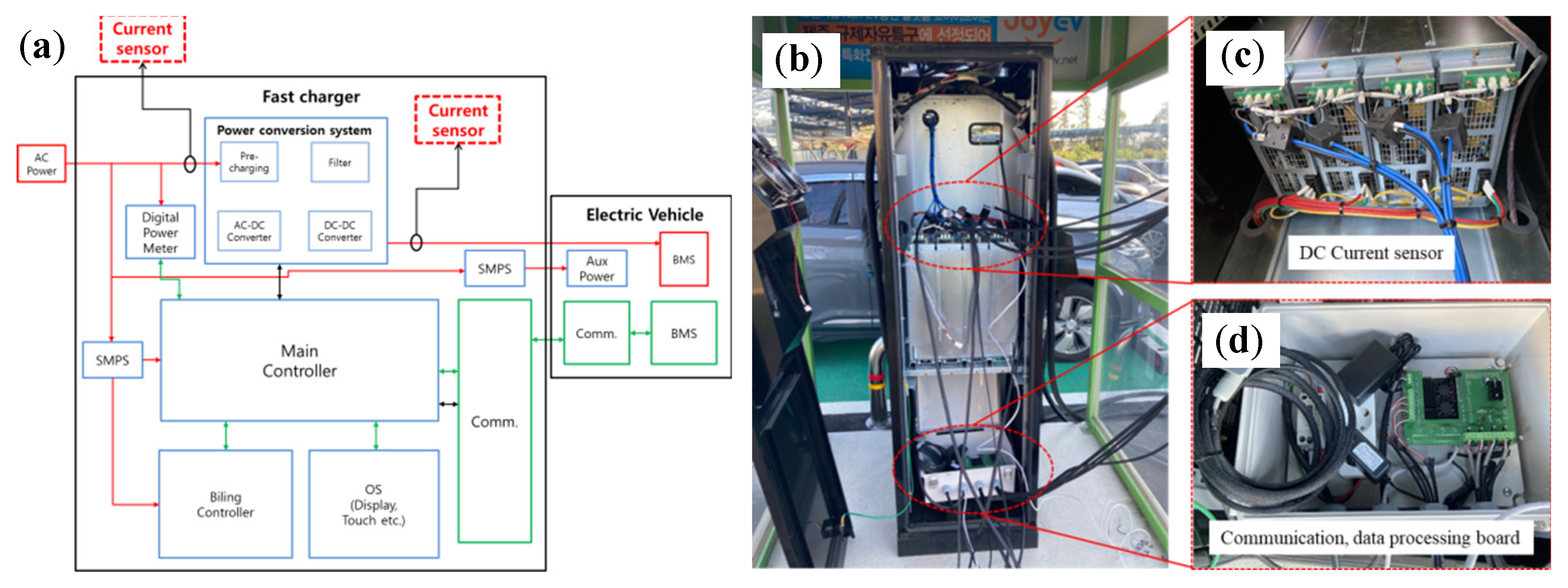
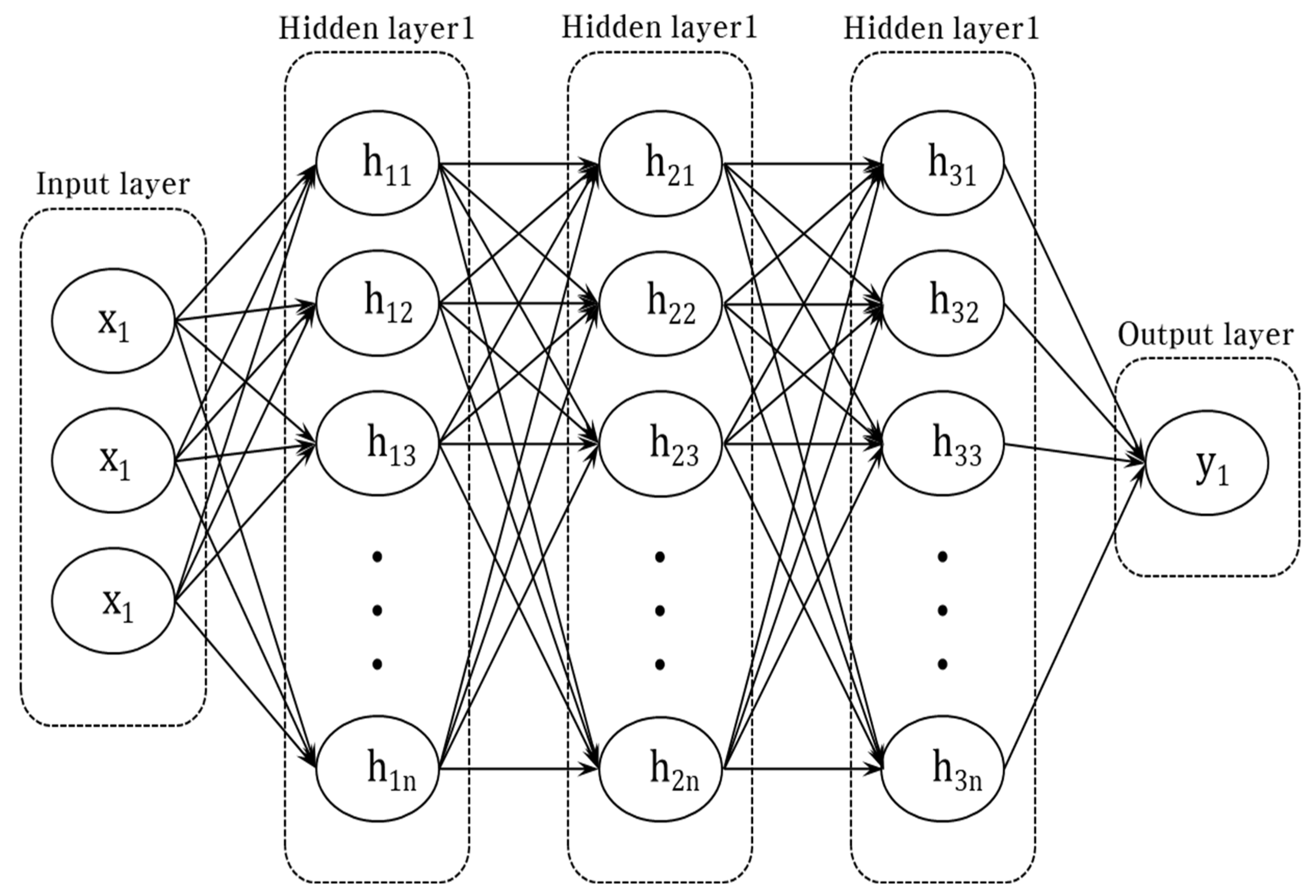
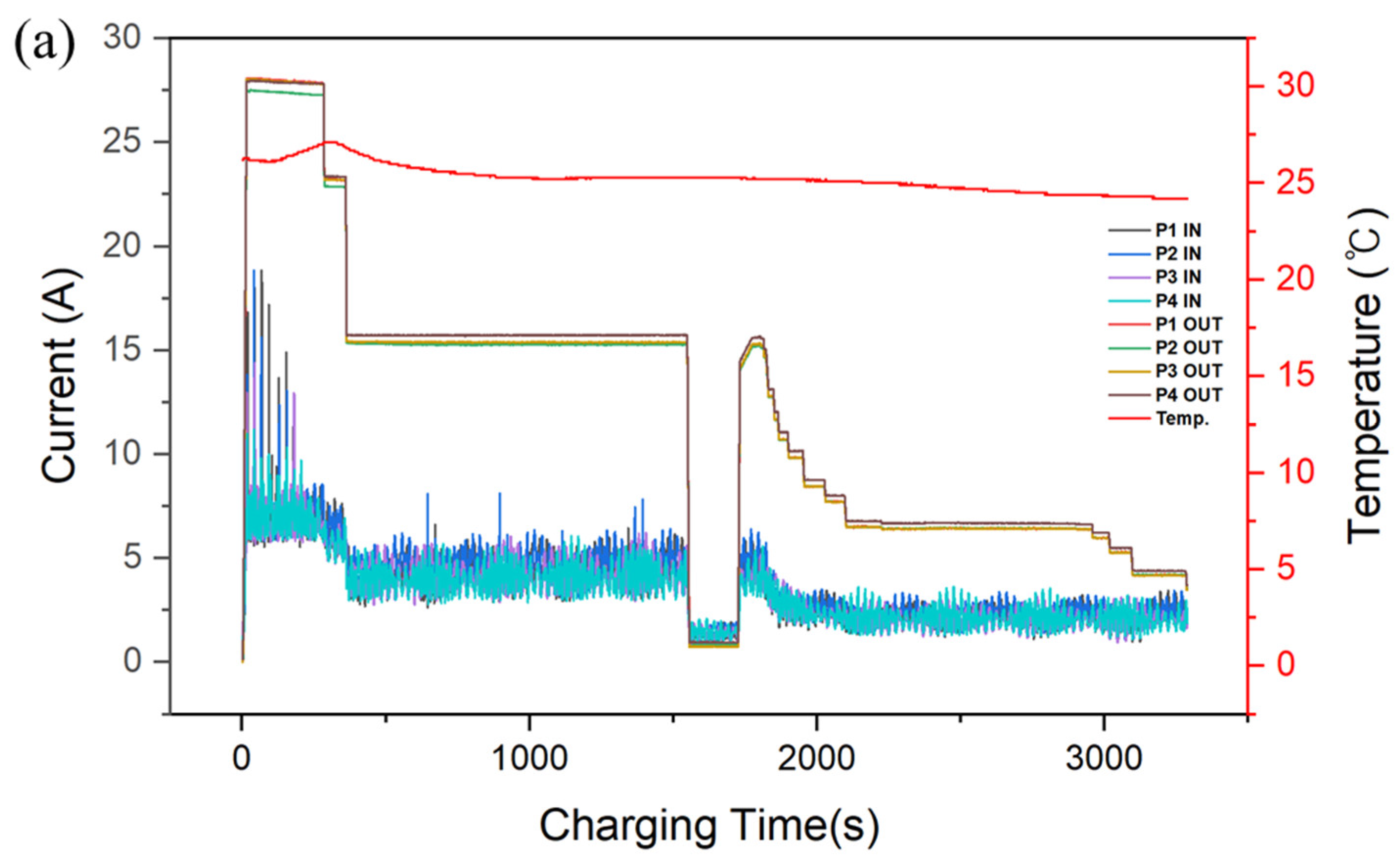
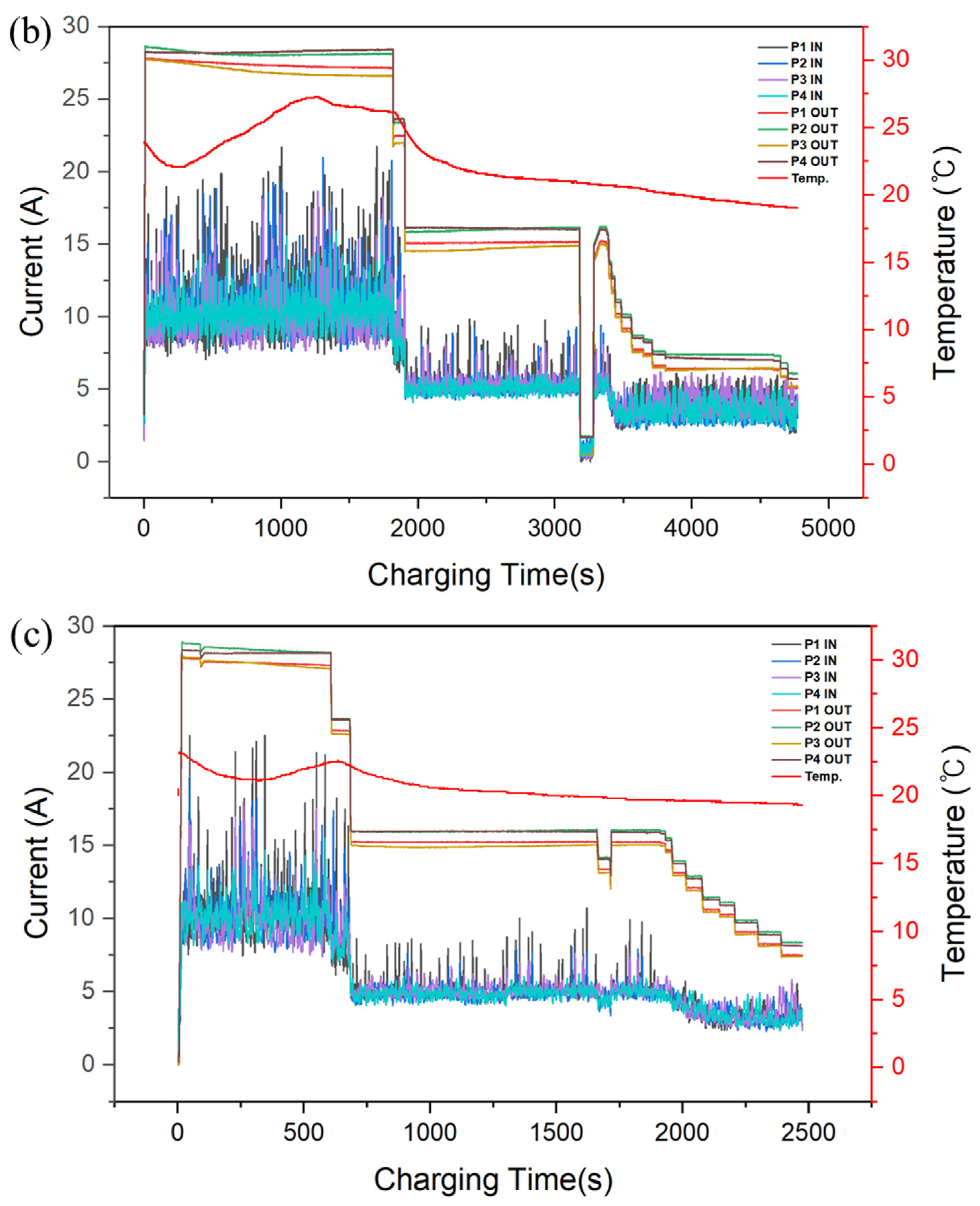
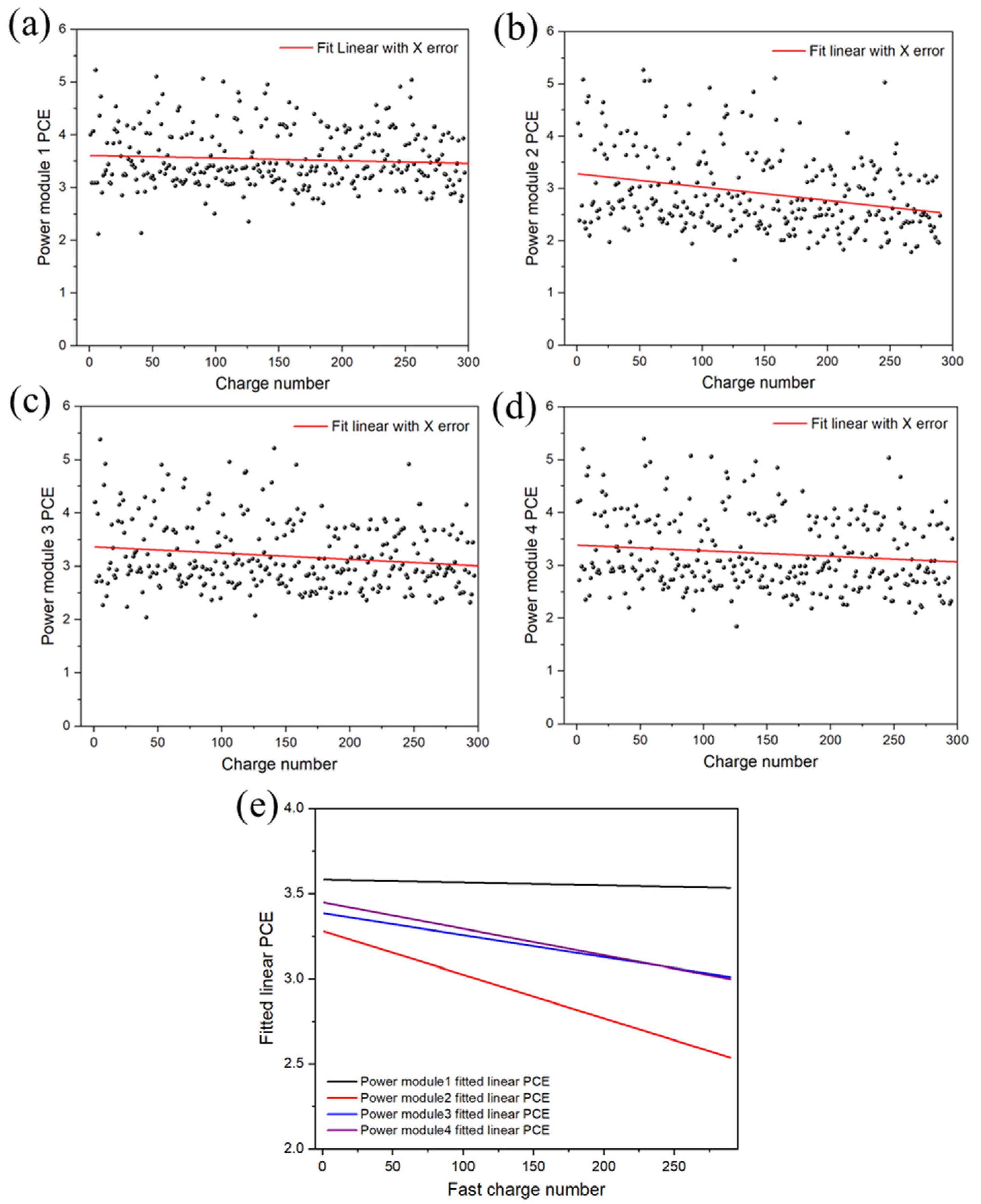
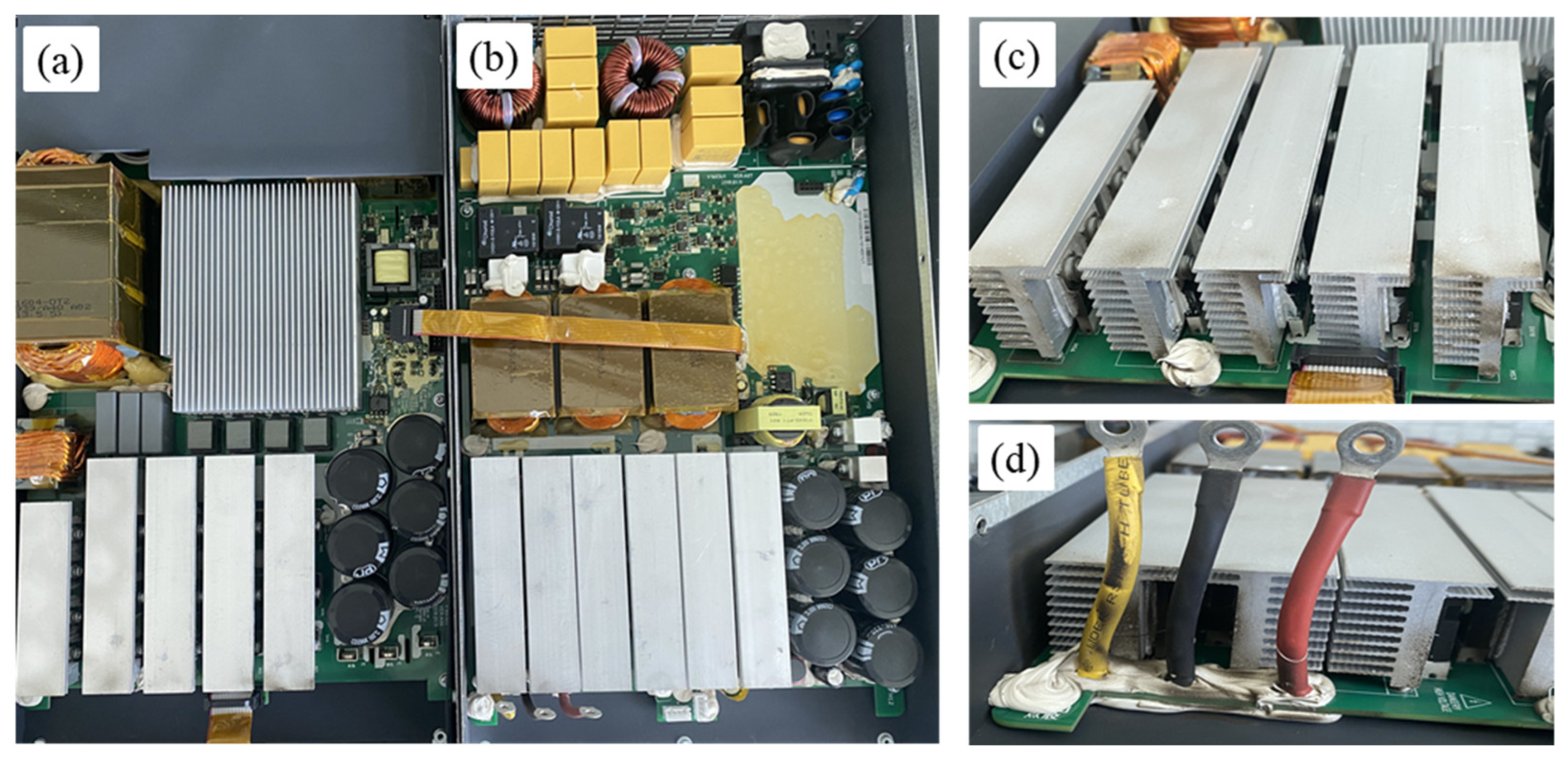
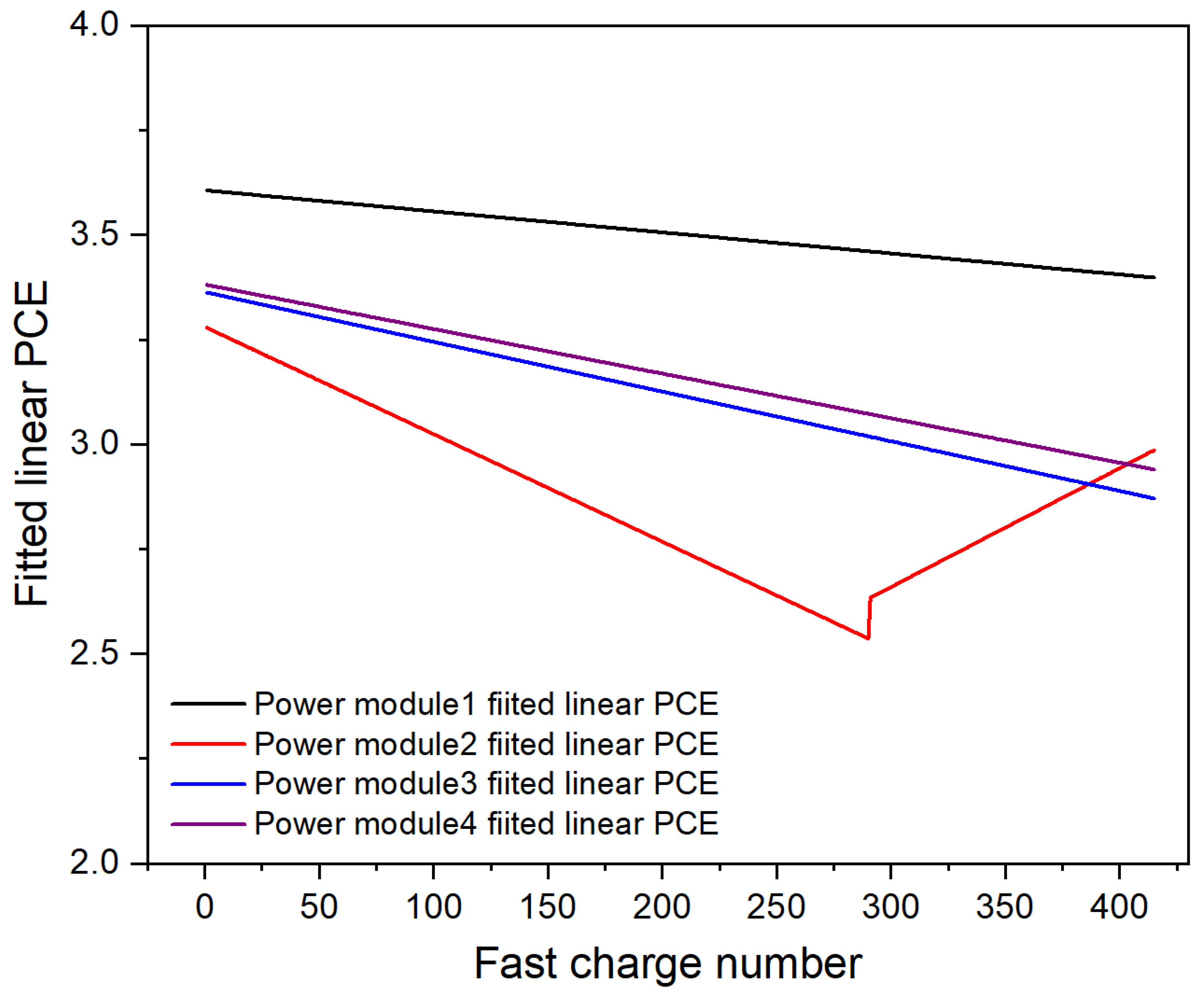
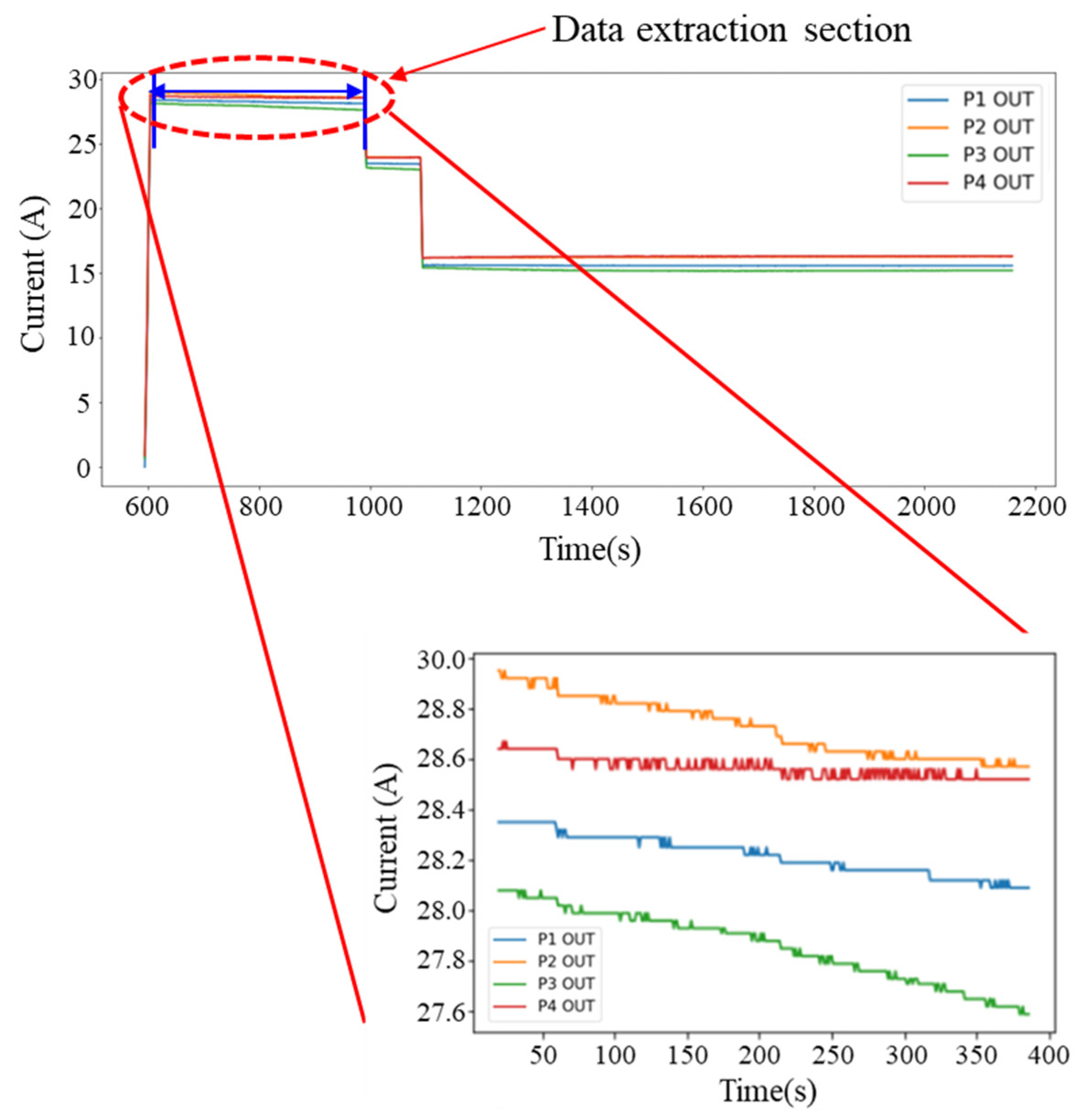
| EV Fast Charger Specifications | ||
|---|---|---|
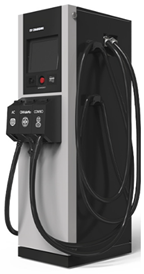 | Charging method |
|
| Input |
| |
| Output |
| |
| Efficiency/Power Factor |
| |
| Environmental conditions |
| |
| Product Certification |
| |
| Safety functions |
| |
| Classification | Data Collection Type | Model Name (Manufacturer) | Main Specifications |
|---|---|---|---|
| AC current sensor | Input current (A) | FS9L8 (Fine-trans, Korea) |
|
| DC current sensor | Output current (A) | FDS20L1 (Fine-trans, Korea) |
|
| Temperature/humidity sensor | Temperature, humidity | CM2305-WP (C-linktech, Korea) |
|
| Communication board | - | Arduino Due (Arduino, Italia) |
|
| Data processing device | - | Raspberry Pi (Raspberry-Pi, UK) |
|
| Classification | Feature Data Calculation |
|---|---|
| Feature 1 | Slope MAX–MIN of four power Modules |
| Feature 2 | Average value of slope of four power modules |
| Feature 3 | Slope standard deviation values of four power modules |
| Feature 4 | Number of abnormal signal data |
| Charging Pattern | Number of Training Data | Number of Validation Data | Classification Accuracy Charging Pattern (%) |
|---|---|---|---|
| Normal charging pattern | 143 | 2 | 98.2 |
| Power-module-aging charging pattern | 3 | 2 | 95.4 |
| Poor-cable-contact charging pattern | 4 | 2 | 97.9 |
| Average | 97.2 | ||
Publisher’s Note: MDPI stays neutral with regard to jurisdictional claims in published maps and institutional affiliations. |
© 2022 by the authors. Licensee MDPI, Basel, Switzerland. This article is an open access article distributed under the terms and conditions of the Creative Commons Attribution (CC BY) license (https://creativecommons.org/licenses/by/4.0/).
Share and Cite
Park, S.-J.; Kim, W.-J.; Kang, B.-S.; Jang, S.-H.; Choi, Y.-J.; Hong, Y.-S. Development of a Fault-Diagnosis System through the Power Conversion Module of an Electric Vehicle Fast Charger. Energies 2022, 15, 5056. https://doi.org/10.3390/en15145056
Park S-J, Kim W-J, Kang B-S, Jang S-H, Choi Y-J, Hong Y-S. Development of a Fault-Diagnosis System through the Power Conversion Module of an Electric Vehicle Fast Charger. Energies. 2022; 15(14):5056. https://doi.org/10.3390/en15145056
Chicago/Turabian StylePark, Sang-Jun, Woo-Joong Kim, Byeong-Su Kang, Sung-Hyun Jang, Yeong-Jun Choi, and Young-Sun Hong. 2022. "Development of a Fault-Diagnosis System through the Power Conversion Module of an Electric Vehicle Fast Charger" Energies 15, no. 14: 5056. https://doi.org/10.3390/en15145056
APA StylePark, S.-J., Kim, W.-J., Kang, B.-S., Jang, S.-H., Choi, Y.-J., & Hong, Y.-S. (2022). Development of a Fault-Diagnosis System through the Power Conversion Module of an Electric Vehicle Fast Charger. Energies, 15(14), 5056. https://doi.org/10.3390/en15145056






